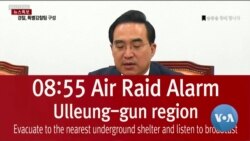ເກົາຫຼີເໜືອ ໄດ້ຍິງລູກສອນໄຟຫຼາຍກວ່າ 20 ລູກໃນວັດພຸດທີ່ຜ່ານມານີ້ ຮວມທັງຢ່າງໜ້ອຍສາມລູກ ຍິງເຂົ້າໄປໃນດິນແດນຂອງເກົາຫຼີໃຕ້. ການຍິງລູກສອນໄຟທັງຫຼາຍນັ້ນ ໄດ້ກະຕຸ້ນໃຫ້ມີການແຈ້ງເຕືອນຜ່ານທາງໂທລະພາບ ໃນເກົາຫຼີໃຕ້ ແລະມີການເປີດສັນຍານເຕືອນໄພທາງອາກາດ ຢູ່ທີ່ເກາະດອນແຫ່ງນຶ່ງນອກແຄມຝັ່ງຂອງເກົາຫຼີໃຕ້. ບີລ ກາໂລ ນັກຂ່າວວີໂອເອ ມີລາຍລະອຽດຕື່ມ ໃນນະຄອນຫຼວງໂຊລ ຂອງເກົາຫຼີໃຕ້ ເຊິ່ງໄຊຈະເລີນສຸກ ຈະນຳມາສະເໜີທ່ານ.
ສຽງສັນຍານເຕືອນໄພທາງອາກາດ ດັງກ້ອງຢູ່ໂທລະພາບຂອງເກົາຫຼີໃຕ້ ທີ່ແຈ້ງເຕືອນພົນລະເມືອງໃຫ້ຍົກຍ້າຍໜີ. ການຍິງລູກສອນໄຟຫຼາຍລູກລຽນຕິດຂອງເກົາຫຼີເໜືອ ທີ່ບໍ່ເຄີຍມີມາກ່ອນ ຊຶ່ງໄດ້ເພີ້ມໃສ່ ຈຳນວນຂອງການຍິງທີ່ຫຼາຍເປັນປະຫວັດການພາຍໃນປີນີ້.
ການຍິງລູກສອນໄຟນັ້ນ ເກີດຂຶ້ນຢູ່ເລື້ອຍໆ ຊຶ່ງເຮັດໃຫ້ພົນລະເມືອງຂອງເກົາຫຼີໃຕ້ ເກືອບບໍ່ສັງເກດເລີຍ.
ແຕ່ຢູ່ທີ່ເກາະອູລເລິງຂອງເກົາຫຼີໃຕ້ນັ້ນ ພົນລະເມືອງໄດ້ຍິນສຽງສັນຍານເຕືອນໄພທາງອາກາດ.
ລູກສອນໄຟຂອງເກົາຫຼີເໜືອອີກລູກນຶ່ງຕົກລົງຢູ່ທາງພາກໃຕ້ຂອງເຂດຊາຍແດນທາງທະເລທີ່ເປັນຢູ່ໃນປັດຈຸບັນ.
ທ່ານກາງ ຊິນ-ຈູລ ເປັນຜູ້ອຳນວຍການໃຫຍ່ ຫົວໜ້າເສນາທິການຮ່ວມຂອງເກົາຫຼີໃຕ້ ກ່າວວ່າ “ອັນນີ້ເປັນເທື່ອທຳອິດ ນັບຕັ້ງແຕ່ແຫຼມແຫ່ງນີ້ໄດ້ຖືກແບ່ງແຍກ ທີ່ລູກສອນໄຟຂອງເກົາຫຼີເໜືອ ໄດ້ຕົກລົງທາງໃຕ້ ຂອງເຂດຊາຍແດນກ້ຳເໜືອສຸດ ຫຼື Northern Limit Line. ມັນເປັນເຫດການທີ່ບໍ່ຄ່ອຍມີ ແລະພວກເຮົາບໍ່ສາມາດຮັບເອົາມັນໄດ້ເລີຍ.”
ໃນການຕອບໂຕ້ ເຮືອບິນລົບຂອງເກົາຫຼີໃຕ້ຈຳນວນນຶ່ງ ໄດ້ຍິງລູກສອນໄຟສາມລູກ ຂ້າມໄປໃນເຂດຊາຍແດນທາງທະເລ. ມັນເປັນຄັ້ງທຳອິດ ນັບຕັ້ງແຕ່ຊຸມປີ 1950 ເປັນຕົ້ນມາ ສຳລັບແຕ່ລະປະເທດ ທີ່ຈະເອົາບາດກ້າວແບບນັ້ນ. ໃນວັນພຸດຜ່ານມານີ້ ທັງສອງປະເທດ ໄດ້ເຮັດເຊັ່ນນັ້ນ.
ເກົາຫຼີເໜືອ ບໍ່ພໍໃຈຍ້ອນ ສະຫະລັດ ແລະເກົາຫຼີໃຕ້ ດຳເນີນການຊ້ອມລົບຮ່ວມກັນ. ເກົາຫຼີເໜືອ ເຫັນການຊ້ອມລົບຕ່າງໆ ເປັນການເກາະຜິດ. ວໍຊິງຕັນກ່າວວ່າ ການຊ້ອມລົບທັງຫຼາຍ ແມ່ນມີລັກສະນະໃນການປ້ອງກັນ.
ເຮືອບິນລົບຫຼາຍຮ້ອຍລຳ ໄດ້ມີສ່ວນຮ່ວມໃນການຊ້ອມລົບທາງທະຫານຄັ້ງຫຼ້າສຸດນີ້ ຊຶ່ງໄດ້ດຳເນີນໄປຈົນເຖິງວັນສຸກຜ່ານມານີ້.
ທ່ານແອນຄິດ ປານດາ ປະຈຳຢູ່ອົງການ Carnegie Endowment for International Peace, ທ່ານເປັນຫ່ວງວ່າ ຄວາມເຄັ່ງຕຶງ ອາດຈະສືບຕໍ່ໄປຈົນເຖິງຂັ້ນທີ່ເປັນອັນຕະລາຍ.
ທ່ານປານດາ ເວົ້າວ່າ “ສະພາບການທີ່ຄວບຄຸມບໍ່ໄດ້ແລ້ວນັ້ນ ກໍແມ່ນວ່າ ທັງສອງຝ່າຍຈະຮູ້ສຶກຕ້ອງໄດ້ຍົກລະດັບການເດີມພັນຂຶ້ນເລື້ອຍໆ. ພວກຊາວເກົາ ຫຼີເໜືອ ຍັງມີການທົດລອງນິວເຄລຍໃນມືຢູ່. ແຕ່ຂ້າພະເຈົ້າຍັງເປັນຫ່ວງວ່າ ອັນນັ້ນຈະບໍ່ພຽງພໍສຳລັບພວກເຂົາ. ອັນນີ້ອາດຈະນຳໄປສູ່ຈຸດໝາຍ ທີ່ເປັນອັນຕະລາຍຫຼາຍຂຶ້ນອີກ.”
ເກົາຫຼີເໜືອ ແມ່ນຍັງຄາດໝາຍວ່າ ຈະສືບຕໍ່ ນຳອອກມາສະແດງໃຫ້ເຫັນ ເຖິງແສນຍານຸພາບດ້ານການທະຫານຂອງຕົນ. ໂດຍທີ່ແຕ່ລະຝ່າຍ ຕ່າງກໍຖິ້ມໂທດໃສ່ກັນແລະກັນສຳລັບຄວາມເຄັ່ງຕຶງທີ່ເພີ້ມຂຶ້ນນັບມື້ ຊຶ່ງມັນຍາກຫຼາຍໃນເວລານີ້ ທີ່ຈະເຫັນວ່າ ບ່ອນໃດທີ່ວົງຈອນຂອງຄວາມເຄັ່ງຕຶງນີ້ ຈະຍຸຕິລົງ.
North Korea fired more than 20 missiles Wednesday, including at least three toward South Korean territory. The missiles triggered alerts on televisions in South Korea and air raid sirens on an island off the coast. More from VOA’s Bill Gallo in Seoul, South Korea.
Air raid alarms blaring on South Korean television, warning residents to evacuate.
North Korea’s unprecedented missile barrage added to its record-high number of launches this year.
The launches happen so frequently that most South Korean residents barely notice.
But on South Korea’s Ulleung island, residents heard loud air raid alerts.
Another North Korean missile landed south of the de facto sea border.
Kang Shin-chul is the Director General of South Korea’s Joint Chiefs of Staff.
((Kang Shin-chul - in Korean))
He says this is the first time since the division of the peninsula that a North Korean missile has landed south of the Northern Limit Line. It is very rare, and we can never tolerate it, he says.
In response, South Korean warplanes launched three missiles across the sea border. It is the first time since the 1950s for either country to take that step. On Wednesday, they both did.
North Korea is upset at the United States and South Korea for conducting joint military drills. The North sees the exercises as provocations. Washington says the drills are defensive.
Hundreds of warplanes are involved in the latest military drills, which run until Friday.
Ankit Panda is with the Carnegie Endowment for International Peace. He worries tensions could continue to spiral dangerously.
((Ankit Panda says))
“The spiral dynamic is that both sides will feel compelled to keep upping the ante. The North Koreans still have the nuclear test card to play. But I also worry that that won't be sufficient for them. This could be leading to a much more dangerous destination.”
North Korea is also expected to continue its displays of military strength. With each side blaming the other for raising tensions, it’s hard for now to see where the cycle of tensions ends.





